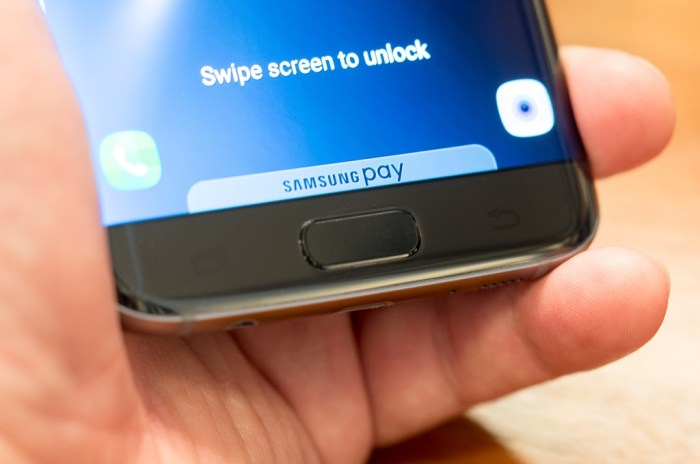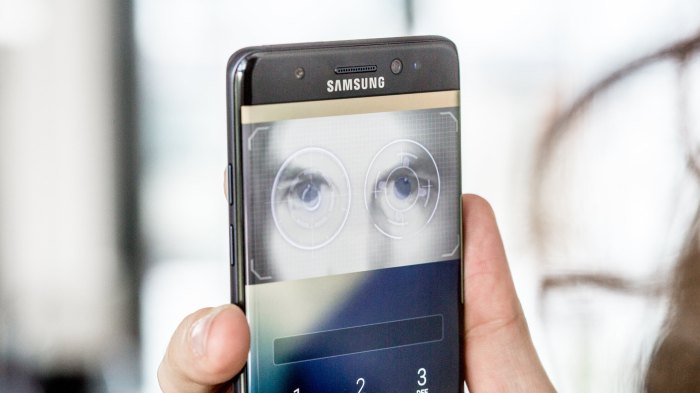Samsung Pay Iris Scanner
Samsung Pay, a mobile payment platform, has been around since 2015. The platform initially relied on NFC technology for contactless payments. However, Samsung recognized the need for enhanced security and introduced iris scanning technology in 2016 with the release of the Galaxy Note 7.
The iris scanner, located on the front of the device, utilizes infrared light to capture a detailed image of the user’s iris. This unique pattern is then encrypted and stored securely on the device. When making a payment, the iris scanner verifies the user’s identity, providing an extra layer of security beyond traditional PIN or password authentication.
Security Advantages and Potential Vulnerabilities
Iris scanning offers a high level of security due to the unique and complex pattern of the iris. The iris is considered a highly reliable biometric identifier, making it difficult to forge or duplicate. The technology also offers a hands-free authentication experience, making it convenient for users. However, there are potential vulnerabilities to consider.
- Spoofing Attacks: A spoofed iris image could potentially bypass the authentication system. This could involve using a high-quality photograph or a 3D model of the iris. However, Samsung has implemented measures to mitigate this risk, such as using advanced algorithms to detect spoofing attempts.
- Privacy Concerns: The collection and storage of biometric data raise privacy concerns. Samsung has implemented measures to protect user data, such as encrypting the iris scan data and storing it locally on the device.
- Technical Limitations: Iris scanning technology can be affected by factors such as lighting conditions and the user’s eye health. For example, individuals with certain eye conditions or who wear contact lenses may have difficulty using the iris scanner.
Recent Updates to Samsung Pay Iris Scanner
Samsung Pay’s iris scanner has undergone several updates to enhance its security and user experience. These updates aim to make the payment process smoother, more secure, and more convenient for users.
Improved Iris Recognition Accuracy
The latest updates to the Samsung Pay iris scanner focus on improving its accuracy and speed. This improvement stems from the implementation of advanced algorithms that can better identify and analyze iris patterns. The new algorithms can distinguish between different irises with greater precision, reducing the chances of false positives and making the authentication process more reliable.
User Experience and Usability
Samsung Pay’s iris scanner, a biometric authentication feature, offers a secure and convenient way to access your payments. It provides a seamless and intuitive user experience, making it a highly desirable feature for users.
Ease of Use and Convenience
The iris scanning process is straightforward and user-friendly. To initiate a payment, simply glance at your phone’s camera. The iris scanner swiftly captures your unique eye pattern and authenticates your identity. This eliminates the need for passwords or PINs, simplifying the payment process.
“The iris scanner is incredibly convenient. I can simply look at my phone and make a payment without having to fumble with passwords or PINs,” said a satisfied Samsung Pay user.
User Feedback and Reviews
User feedback on the iris scanner has been overwhelmingly positive. Many users appreciate the enhanced security and convenience it provides.
“The iris scanner is a game-changer. It’s fast, accurate, and adds an extra layer of security to my payments,” shared another Samsung Pay user.
- The iris scanner’s accuracy and speed are often praised, making it a reliable and efficient authentication method.
- Users also highlight the convenience of not having to remember multiple passwords or PINs.
- Some users have expressed concerns about the scanner’s performance in dimly lit environments, but Samsung has addressed this issue in recent updates.
Technical Aspects and Implementation: Samsung Pay Updated Iris Scanner
Samsung Pay’s iris scanning technology is a marvel of modern engineering, combining sophisticated hardware and software to deliver secure and convenient authentication. This section delves into the technical intricacies of this biometric authentication system, exploring the underlying algorithms and the components that make it work.
Iris Recognition Algorithms
Iris recognition algorithms are the brains behind Samsung Pay’s secure authentication. They analyze the unique patterns within the iris, comparing them to a stored template. The process involves several steps:
- Image Acquisition: The iris scanner captures a high-resolution image of the user’s iris. The camera captures the iris pattern, focusing on the details of the intricate structures.
- Pre-processing: The captured image is pre-processed to remove noise and artifacts, ensuring a clear and accurate representation of the iris. This step enhances the quality of the image, making it suitable for analysis.
- Feature Extraction: The pre-processed image is then analyzed to extract unique features, such as the texture, shape, and color patterns of the iris. These features are mathematically represented as a set of data points.
- Template Generation: The extracted features are then converted into a compressed template, which is stored securely on the device. This template represents the unique characteristics of the user’s iris.
- Matching: When the user attempts to authenticate, the scanner captures a new iris image. This image is processed, and its features are compared to the stored template. If the features match within a predefined threshold, the authentication is successful.
Hardware and Software Components
The iris scanner in Samsung Pay is a complex system that involves specialized hardware and software components:
- Iris Scanner: The iris scanner is a dedicated camera module that captures high-resolution images of the user’s iris. It is typically integrated into the device’s display or located near the front camera.
- Image Processing Unit: The image processing unit is responsible for pre-processing and analyzing the captured iris images. It performs operations like noise reduction, artifact removal, and feature extraction.
- Secure Element: The secure element is a tamper-resistant hardware component that stores the user’s iris template securely. This ensures that the template is protected from unauthorized access.
- Iris Recognition Software: The iris recognition software is the core of the authentication system. It implements the algorithms for feature extraction, template generation, and matching. It also handles communication with the hardware components and the operating system.
Security and Privacy
Samsung Pay’s iris scanning technology prioritizes security and privacy. The iris template is encrypted and stored securely within the device’s secure element. This ensures that the template is protected from unauthorized access and cannot be easily copied or stolen. The system also uses advanced security measures to prevent spoofing attempts, ensuring that only legitimate users can access the device.
Comparison with Other Authentication Methods
Samsung Pay’s iris scanner isn’t the only authentication method available. It’s important to compare it with other methods to understand its strengths and weaknesses. This comparison will help you decide which method suits your needs best.
Comparison of Authentication Methods
Here’s a breakdown of different authentication methods used in Samsung Pay and their pros and cons:
- Pin: A PIN is a numerical code that users create and enter to access their Samsung Pay account.
- Pros: Simple to use, familiar to most users.
- Cons: Less secure than biometric methods, can be easily forgotten or compromised.
- Pattern: A pattern is a graphical gesture that users draw on their screen to unlock their device.
- Pros: Relatively secure, easy to remember.
- Cons: Can be compromised if observed, not as secure as biometric methods.
- Fingerprint: Fingerprint scanning uses a sensor to read the unique patterns on a user’s finger.
- Pros: Highly secure, convenient to use.
- Cons: Fingerprints can be damaged, making it difficult to scan.
- Face Recognition: Face recognition uses a camera to identify a user’s face.
- Pros: Convenient, can be used without touching the phone.
- Cons: Less secure than iris scanning, can be fooled by photos or videos.
- Iris Scanning: Iris scanning uses a camera to scan the unique patterns in a user’s iris.
- Pros: Extremely secure, difficult to spoof.
- Cons: Requires good lighting, can be inconvenient in certain situations.
Future of Biometric Authentication
Biometric authentication is expected to become increasingly popular in mobile payments. As technology advances, these methods will become more secure and convenient. For example, we might see the development of more sophisticated facial recognition systems that can identify users even in low-light conditions. Additionally, new technologies like vein recognition and voice recognition are being explored for authentication purposes.
Security and Privacy Considerations
Iris scanning, a biometric authentication method, is becoming increasingly popular for mobile payments, offering a secure and convenient way to verify user identity. However, like any technology, it comes with its own set of security and privacy concerns that must be carefully addressed.
This section explores the security implications of using iris scanning for mobile payments, the measures taken to protect user data, and the potential privacy concerns associated with the collection and storage of iris data.
Security Implications of Iris Scanning
Iris scanning is considered a highly secure authentication method due to the unique and complex patterns within the iris. Each iris is distinct, making it difficult to forge or replicate. However, certain security vulnerabilities must be considered:
- Spoofing Attacks: Advanced techniques can potentially create fake iris images that can trick the scanner. However, Samsung Pay uses sophisticated algorithms and anti-spoofing measures to detect such attempts.
- Data Breaches: If the database storing iris data is compromised, it could lead to unauthorized access and identity theft. Samsung Pay employs robust security measures, including encryption and multi-factor authentication, to protect user data.
- Hardware Vulnerabilities: Potential vulnerabilities in the iris scanner itself could allow attackers to bypass security measures. Samsung Pay continuously updates its security protocols and patches vulnerabilities to ensure the safety of user data.
Measures to Protect User Data
Samsung Pay prioritizes the security of user data and implements various measures to protect iris information:
- Encryption: Iris data is encrypted both during transmission and storage, making it unreadable to unauthorized individuals.
- Secure Storage: Iris data is stored securely on the device itself, rather than on a centralized server, minimizing the risk of data breaches.
- Multi-Factor Authentication: In addition to iris scanning, Samsung Pay often requires additional authentication methods, such as PIN or password, to further enhance security.
- Regular Security Updates: Samsung Pay continuously updates its security protocols and patches vulnerabilities to ensure the safety of user data.
Privacy Concerns Associated with Iris Data, Samsung pay updated iris scanner
While iris scanning offers high security, it also raises privacy concerns:
- Data Collection and Storage: The collection and storage of sensitive biometric data, like iris scans, raise concerns about potential misuse or unauthorized access.
- Data Retention: The duration for which iris data is stored and the purpose for its retention are important considerations. Samsung Pay has a clear policy on data retention and deletion.
- Data Sharing: Concerns exist regarding the potential for data sharing with third parties, especially for marketing or other purposes. Samsung Pay does not share user data with third parties without explicit consent.
Samsung pay updated iris scanner – The updated Samsung Pay iris scanner is a testament to the company’s commitment to innovation and security. It’s a powerful example of how technology can be used to make our lives easier and more secure. The future of mobile payments is bright, and Samsung Pay is at the forefront, leading the way with its cutting-edge iris scanning technology.
Samsung Pay’s updated iris scanner promises enhanced security and convenience, making it even easier to pay with your phone. But if you’re thinking of upgrading your gaming setup for Forza Horizon 3, you’ll want to check out the forza horizon 3 pc system requirements confirmed to make sure your rig can handle the action. Once you’re all set up, you can enjoy the thrill of racing with the peace of mind that comes with Samsung Pay’s secure authentication.
 Standi Techno News
Standi Techno News

